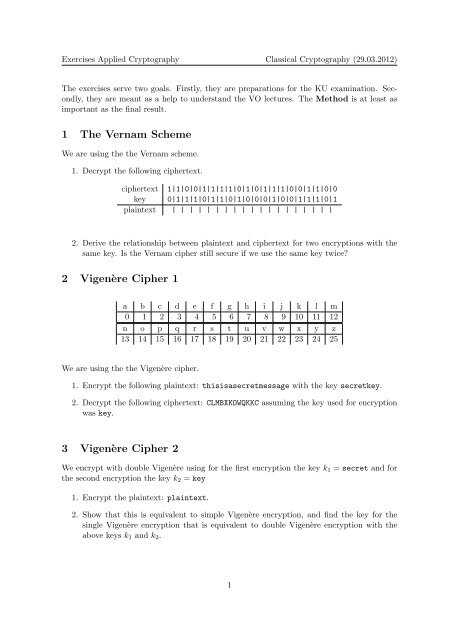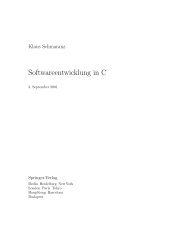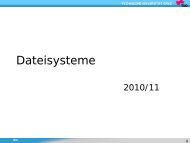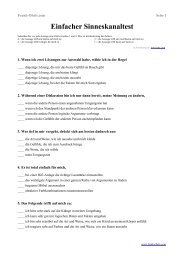1 The Vernam Scheme 2 Vigen`ere Cipher 1 3 Vigen`ere Cipher 2
1 The Vernam Scheme 2 Vigen`ere Cipher 1 3 Vigen`ere Cipher 2
1 The Vernam Scheme 2 Vigen`ere Cipher 1 3 Vigen`ere Cipher 2
You also want an ePaper? Increase the reach of your titles
YUMPU automatically turns print PDFs into web optimized ePapers that Google loves.
Exercises Applied Cryptography Classical Cryptography (29.03.2012)<br />
<strong>The</strong> exercises serve two goals. Firstly, they are preparations for the KU examination. Secondly,<br />
they are meant as a help to understand the VO lectures. <strong>The</strong> Method is at least as<br />
important as the final result.<br />
1 <strong>The</strong> <strong>Vernam</strong> <strong>Scheme</strong><br />
We are using the the <strong>Vernam</strong> scheme.<br />
1. Decrypt the following ciphertext.<br />
ciphertext 1|1|0|0|1|1|1|1|0|1|0|1|1|1|0|0|1|1|0|0<br />
key 0|1|1|1|0|1|1|0|1|0|0|0|1|0|0|1|1|1|0|1<br />
plaintext | | | | | | | | | | | | | | | | | | |<br />
2. Derive the relationship between plaintext and ciphertext for two encryptions with the<br />
same key. Is the <strong>Vernam</strong> cipher still secure if we use the same key twice?<br />
2 Vigenère <strong>Cipher</strong> 1<br />
a b c d e f g h i j k l m<br />
0 1 2 3 4 5 6 7 8 9 10 11 12<br />
n o p q r s t u v w x y z<br />
13 14 15 16 17 18 19 20 21 22 23 24 25<br />
We are using the the Vigenère cipher.<br />
1. Encrypt the following plaintext: thisisasecretmessage with the key secretkey.<br />
2. Decrypt the following ciphertext: CLMBXKOWQKKC assuming the key used for encryption<br />
was key.<br />
3 Vigenère <strong>Cipher</strong> 2<br />
We encrypt with double Vigenère using for the first encryption the key k 1 = secret and for<br />
the second encryption the key k 2 = key<br />
1. Encrypt the plaintext: plaintext.<br />
2. Show that this is equivalent to simple Vigenère encryption, and find the key for the<br />
single Vigenère encryption that is equivalent to double Vigenère encryption with the<br />
above keys k 1 and k 2 .<br />
1
Exercises Applied Cryptography Classical Cryptography (29.03.2012)<br />
4 Affine <strong>Cipher</strong>s<br />
We used an affine cipher c = a · p + b mod 26 for encryption, where c is the ciphertext, p is<br />
the plaintext, and (a, b) is the key.<br />
1. Explain how decryption works. What can you say about the key (a, b)?<br />
2. <strong>The</strong> key (15,4) was used for encryption. Give the decryption key and find the plaintext<br />
for the following ciphertext: ciphertext.<br />
5 Basic Cryptanalysis 1<br />
In this example we will perform a known plaintext attack. This is an attack where the<br />
adversary knows a plaintext and the according ciphertext. <strong>The</strong> aim of the adversary is to find<br />
out which cipher and which key has been used for the encryption. Note that the adversary<br />
in general knows the used cipher (Kerckhoffs’ principle).<br />
plaintext: cryptanalysis<br />
ciphertext: UZKEEEFIXNDMK<br />
1. Which cipher has been used for encryption (Transposition, Caesar, Vigenère)?<br />
2. Determine the key used for encryption.<br />
3. Verify your result for the following ciphertext: LPUHTWLPQZZVJMOIVIQ.<br />
6 Basic Cryptanalysis 2<br />
Given the following ciphertext encrypted using the Vigenère cipher. Determine the key (use<br />
the method you have learned in the lecture). Hint: the period of the used key is 2.<br />
KO|PB|SK|YK|QS|DR|SB|HO|LD|SK|GS|ZI<br />
OX|RG|SU|BY|KO|LK|QD|ZI|VY|KD|CN|CS<br />
HP|CB|HR|WC|SH|OW|DV|SK|ZY|BQ|QS|DR<br />
SB|HO|LD|WC|FO|EE|WB|SN|<br />
2

















